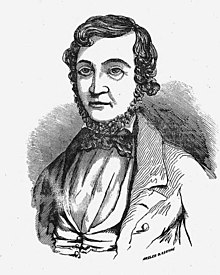Monroe Edwards
| Monroe Edwards | |
|---|---|

A portrait engraving of Edwards from Life and Adventures of the Accomplished Forger and Swindler, Colonel Monroe Edwards, published a year after his death
|
|
| Born | 1808 Danville, Kentucky |
| Died | January 27, 1847 Sing Sing Prison, New York |
| Cause of death | Consumption |
| Nationality | American |
| Occupation | Slave trader |
| Known for | Forgery |
| Criminal charge | Multiple counts of forgery and fraud |
| Criminal penalty | 10 years in prison |
Monroe Edwards (1808 – January 27, 1847) was an American slave trader, forger and convicted criminal who was the subject of a well-publicized trial and conviction in 1842. Originally from Kentucky, Edwards moved to New Orleans then settled in Texas. He smuggled slaves into Brazil in 1832, and used the proceeds to purchase land in Texas. In 1836 he was again smuggling slaves, this time into Texas. After attempting to swindle his partner out of the profits of the venture, partly with forged documents, Edwards was forced to flee the Republic of Texas to the United States. He then tried to scam money out of various abolitionists in the United States and the United Kingdom, partly with forged letters of introduction. He traveled to the United Kingdom, but his schemes were mainly unsuccessful and he returned to the United States in mid-1841.
Edwards' largest swindle involved forged letters from cotton brokers in New Orleans, which he used to secure bank drafts for large sums that he then cashed. His fabrications caught up with him and he was arrested and tried for the forgeries in June 1842. Convicted partly because his distinctive good looks made him memorable and easily recognizable, and partly from making the same spelling errors in his fakes, Edwards was sentenced to 10 years in prison and died in 1847 while incarcerated. Several sensational accounts of his offenses and trial were published after his death, and he was mentioned in Herman Melville's 1853 short story "Bartleby, the Scrivener".
Edwards was born in 1808 in Danville, Kentucky. His father was reported to be Amos Edwards or Moses Edwards, but the name of his mother is unknown. His brother was Amos Edwards, and his uncle was Haden Edwards who lived in Nacogdoches. Nothing is known with certainty of his childhood. As a grown man, he was considered very handsome, and usually dressed fashionably. Some accounts give him the title "Colonel".
Around 1822, Edwards was sent to New Orleans to learn business from a merchant named Mr. Morgan. By the late 1820s Morgan had established a trading post on San Jacinto Bay near Galveston in what was then Mexican Texas. Some time after, Edwards met a slave trader and joined his new acquaintance on a smuggling trip to acquire slaves in Africa. This first effort ended when they were shipwrecked, but a second attempt in 1832 successfully smuggled slaves into Brazil. Edwards invested the profits from this venture into land in Texas, where in late 1833 he established a plantation on the San Bernard River in present-day Brazoria County, Texas; he named his new home "Chenango". Unconnected with his slave trading, Edwards was arrested in 1832 as part of the Anahuac Disturbances, and was briefly imprisoned during the uprising against the Mexican government which ruled Texas.
...
Wikipedia
